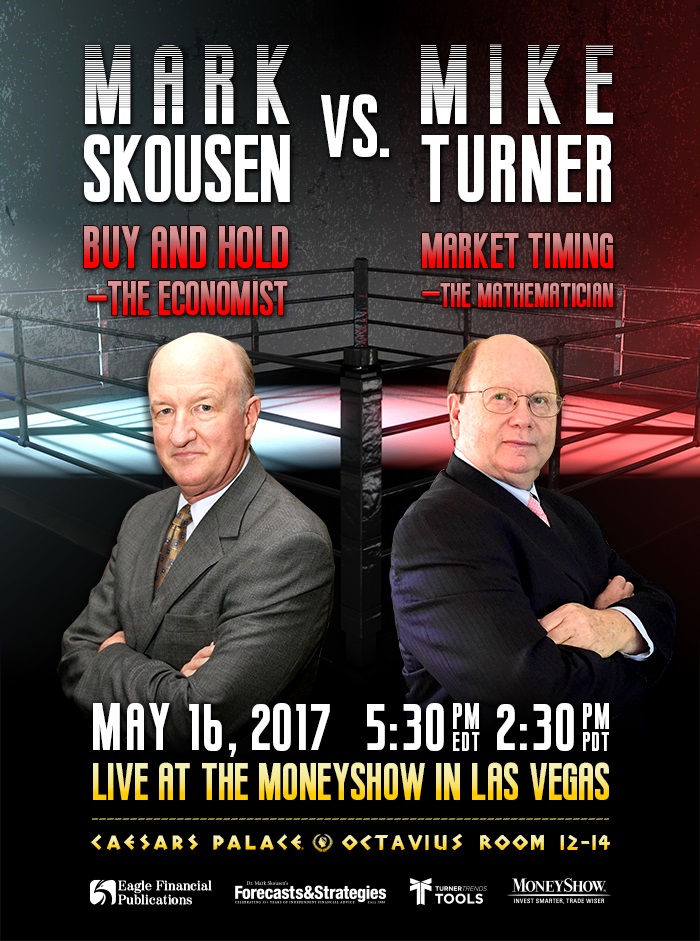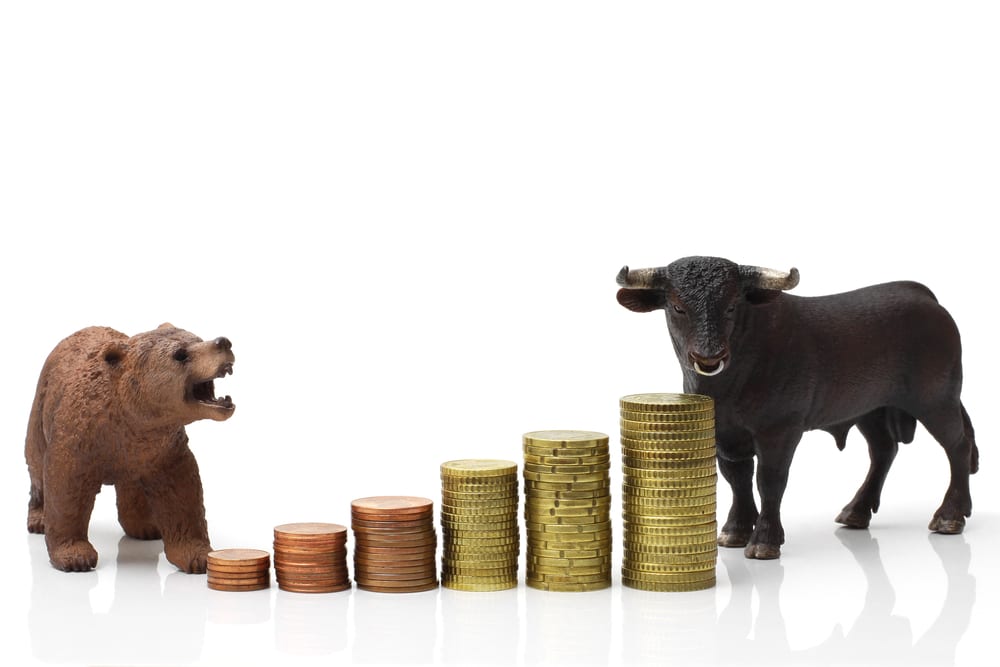Where is the stock market heading? My new gross output (GO) and Skousen B2B Index may have the answer.
Last Friday, the federal government released the full year of 2016 GO, the top line of national income accounting. Nominal GO grew at an astonishing 6.2% annualized rate for fourth-quarter 2016. In real terms, it was 3.6% — which was much higher than gross domestic product (GDP) growth. To read my full press release click here: http://mskousen.com/2017/04/gross-output-and-b2b-index-advance-sharply-after-election/.
The fourth-quarter Skousen B2B index grew even faster at an 8.4% annualized rate for nominal B2B spending, with a 5.8% real rate.
My view: A year ago, GO and B2B spending was in a recession. But the fourth-quarter GO suggests that the Fed’s easy-money policies and Trump’s election have had a positive impact on business spending and outlook, and justifies the stock market rally into 2017. I’m still 100% invested but future rallies will depend on positive news in Washington and around the world. (We just confirmed Senator Mike Lee and Congressman Thomas Massie to speak at FreedomFest and tell us the latest happening on Capitol Hill.)
I will be presenting a paper on GO called “GO Beyond GDP: A Breakthrough in Macroeconomics” at the Mont Pelerin Society meetings in Seoul, Korea, in early May. I will also be meeting with Korean economists and government officials to begin the process of creating a GO statistic for Korea. Let’s hope WW3 doesn’t start while I’m there!
WHAT’S MISSING FROM GDP?
GO tells a lot more than GDP does because it includes the value of the supply chain, the B2B activity that produces the finished goods and services (GDP). GDP failed to identify the business slump in early 2016, and the new business boom.
While GDP may be a reasonable estimate of national welfare and economic growth, it has come under criticism over the years on a variety of counts:
- It is a single number that does not reflect environmental problems in a country, such as pollution, or the threat of global warming.
- It does not measure inequality of wealth or income.
- It vastly underestimates the size and importance of trade. For example, trade in GDP is exports minus imports, giving a minus $545 million in 2016. (We import more than we export.) But if you measure trade as exports plus imports (since they are done by different people and companies), trade represents 26% of GDP in the United States, and almost 60% on average in other nations. Source: http://data.worldbank.org/indicator/NE.TRD.GNFS.ZS
- It does not measure black market activities, barter transactions, or unpaid labor y(such as domestic work). With some exceptions, GDP is meant to account for the value of final goods and services that involved dollar transactions.
- It does not fully measure the size of government involvement in the economy. Government spending is currently less than 20% of GDP, but it deliberately leaves out what economists call “transfer payments,” for example, payments to welfare recipients. Actual government spending in the economy amounts to 38.3% of GDP, according to the Heritage Foundation’s Economic Freedom Index. Source: http://www.heritage.org/index/country/unitedstates
- Last but not least, GDP leaves out the supply chain, all the goods-in-process in the economy. By doing so, GDP vastly overplays the role of consumer spending and government stimulus at the expense of business investment in the economy. Using GDP statistics, consumption expenditures represent by far the largest sector of the economy, with government spending second, and business investment as the smallest. Thus, the financial media and government officials give the false impression that consumer and government spending, rather than business investment, is the main driver of economic growth.
What Really Drives the Economy: Consumer Spending, Government Stimulus, or Business Investment?
Using GO as a broader measure of economic activity, we see that business spending (B2B) is actually over 60% of the U.S. economy, and consumer spending is only about a third. Thus, business spending is the most important sector of the economy: savings, capital investment, technology and entrepreneurship — that’s what creates a higher standard of living.
If the Trump tax reform and deregulation is pushed through Congress, expect to see higher productivity and business investment — and higher stock prices.
In case you missed it, I encourage you to read my e-letter from last week about President Trump’s difficulties with garnering support for his upcoming tax reform.
Upcoming Appearances
Don’t Miss the Big Fight in Vegas!
At this year’s Las Vegas MoneyShow, join me in the ring at Caesars Palace to see me knock out fellow newsletter writer Mike Turner! What is the best investment strategy? I will fight for buying good stocks for the long run while Mike will fight for short-term trading.
I will also be the moderator of a general session in the opening ceremonies with Steve Forbes and Steve Moore on “Trump and Your Portfolio.” Not to be missed.
MoneyShow Las Vegas, May 15-18, 2017, Caesars Palace: Other speakers include Jeffrey Saut, Jim Stack, Pamela Aden, Marilyn Cohn and Matt McCall. I hope to see you there. To register free as my guest, call 1-800-970-4355 or 1-941-955-0323 and mention priority code 042818. Click here if you prefer to sign up online.
You Blew It!
Dissecting the Dodd-Frank Disaster
“Imagine trying to run your business, but then having a government agency hand you a 50,000-page rule book.” — Zacks
The two-year window of Democrats leading the White House and Congress between 2009 and 2011 was a disaster for the United States. That’s when the Democrats had effective control of all branches of government, and pushed through Obamacare, the Dodd-Frank Wall Street Reform and the Consumer Protection Act.
Aside from having a really long and misleadingly innocuous name for such an economic-growth-stifling law, Dodd-Frank imposed heavy new regulations on business, just as Obamacare did.
After Dodd-Frank, the Federal Register published 53,486 pages in regulations on banks and credit unions.
Since 2010, not a single community bank has been created. On Wall Street, Jamie Dimon of J.P. Morgan said that his company has more than $30 billion in capital reserves as “permanently idle capital.” Not only can the bank not lend or invest that money, it can’t do anything with it. For all commercial and investment banks, nearly $2.5 trillion are in excess reserves parked at banks today, due to higher capital ratios imposed by Dodd-Frank regulations.
It’s very difficult to clean up and eliminate unnecessary regulations — it will take years, and may not happen at all. That’s the danger of passing legislation after a crisis such as the one that occurred in 2008.
The law, named after sponsors U.S. Sen. Christopher J. Dodd and U.S. Rep. Barney Frank, was supposed to honor two lawmakers for their work but instead it is another example of how Congress can interfere with private sector activities and hurt free enterprise and job creation. The intent of decreasing risks within the financial system may have been well meant but the result has been to hurt economic growth and stymie bank lending.
Dodd-Frank also added to bureaucracy by establishing a number of new government agencies to oversee various components of the act and the banking system. Now may be a good time to reform Dodd-Frank itself.





